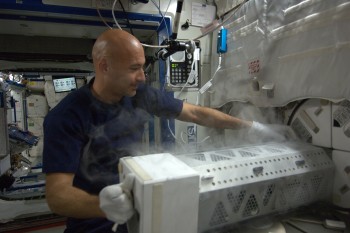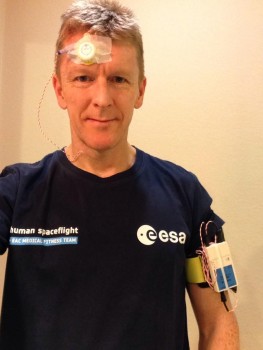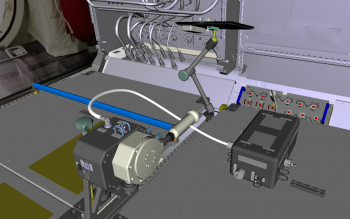Last week saw Tim Peake working on many Japanese experiments looking at his stomach bacteria as well as recording his cardio-vascular health for the Canadian Space Agency and looking at his eyes for NASA. This week due to combined efforts of Scott Kelly, Tim Kopra and Tim Peake the Japanese Electrostatic Levitation Furnace is ready for prep runs. The machine is melting metals suspended in weightlessness and went through the setup and checkout over the last three weeks.

ESA astronaut Luca Parmitano using the Space Station’s freezer for sample storage. Credits: ESA/NASA
Monday Tim spent most of his time in the Japanese Kibo laboratory working on Multi-Omics and preparing for future experiments when the next SpaceX cargo vessel arrives. Tuesday morning Tim took a sample of his saliva and stored it in the freezer, swapped some radiation dosimeters and did an eye exam that was operated remotely by doctors on Earth. He did another ultrasound session for Cardio Ox, went for an hour run on the Station’s treadmill and had a video interview, all before lunch. The afternoon was spent in Kibo again and on the spacesuits used for spacewalks.
Meanwhile cosmonauts Mikhail Korniyenko and Sergei Volkov took samples of their blood and handed them to Tim Kopra for storage as part of the EDOS-2 study that is looking at how bones change and recover during and after spaceflight. The samples will also be used for the IMMUNO-2 experiment that is taking a holistic approach to understanding how humans adapt physiologically to living in space.
Wednesday 10 February Tim swapped out two more dosimeters, had his weekly ESA crew conference and worked the rest of the day on the spacesuits in addition to his two-hour exercise routine. In the evening Tim donned two special temperature sensors that are part of the Circadian Rhythms experiment that aims to chart how astronauts’ body-clocks adapt to living in space where a typical day includes eight sunrises and sunsets as they orbit Earth. This is Tim’s third session that records his biorhythms for 36 hours at a time.
Thursday ended this session of recording sounds around the Space Station. Tim had been wearing a microphone for 24 hours and had placed two microphones around the Station to record ambient noise. The information will help to localise areas that are too loud. More eye exams and air samples followed by spacesuit checking and a check of emergency equipment such as fire extinguishers and portable breathing assemblies. In the evening Tim did an amateur radio contact with a school in Britain that included video over simple radio waves.
Tim’s crewmate Tim Kopra used ESA’s 3D-Vit technology to perform maintenance on the European space laboratory Columbus. He was not trained for this operation on purpose but relied on a 3D visualisation of the task and followed the procedures step by step on his tablet.
Friday included a session on Skin-B looking at astronauts’ skin, powering up a centrifuge to spin blood samples before freezing them for storage as well taking a urine sample. These samples are generic ones for data collection and will be repeated on Saturday.
Next week Tim will start preparing for an experiment in the Station’s airlock that is looking at lung function in astronauts among his many other activities.



Discussion: 15 comments
Hi Tim, hope you are all well, fascinating work you are doing, so so proud of you all, take care, GOD Bless xxxxxxxxxxxx
Wow. I feel exhausted after just reading all that activity!
So interesting – thanks for the info. Very much appreciated.
Wow. Not sitting twiddling your fingers are you. Busy busy busy.
My 7 year old son, Ethan has been hugely inspired by reading what you have been up to in space. He was very excited this week as he saw you fly over twice and he saw the space station through his telescope. Thank you for your inspiration.
Hi tim, I love reading about your adventures onbord the iss. Even my two boys like to look at your photos from space and hear about what you’ve been doing. Keep up the good work for space exploration and science here on earth.
I am following your mission with great interest and track ISS going over whenever I can (and the cloud cover allows!). Fantastic work, see you when you get back!
Experiments sound interesting. Are you carrying out any experiments that may help medical advances her on earth.
Hi Janet, the data from Tim’s experiments can take many years to analyse and process. Have a look at this website for an overview of some of the benefits to humanity: https://www.esa.int/Our_Activities/Human_Spaceflight/International_Space_Station_Benefits_for_Humanity
The pictures of the planet and information about your stint in space is incredibly interesting. All very inspiring. Thank you.
I’m delighted to see all your photographs you post on FB. Fascinating stuff. Marvellous to see these images, especially of north Wales.
Thank you. xx
Very interesting stufff! Do you happen to know what happened to fruit flies @astroSamantha worked on? They survived going up, but I haven’t heard anything about them coming back home. Could you enlighten me please?!
You are doing fascinating work and it must be hugely satisfying. You and your fellow astronauts are an inspiration to many here back home on planet Earth.
Take care.
this is so cool and very interesting
hi Tim you are doing so good and it must be heard up there
Hi
I am a teacher of a Year 5 class who have just finished a topic on space involving lots of work researching and following Tim Peake’s mission. I would now like the children to link their learning to their literacy work and write and send letters to Tim. Is their an address that we can send these letters to in preparation for Tim’s return or is their any other addresses we could send these letters to who may even read and reply to the letters on Tim’s behalf?
Many thanks,
Heather Warren